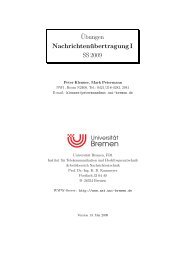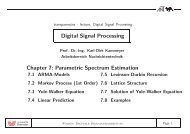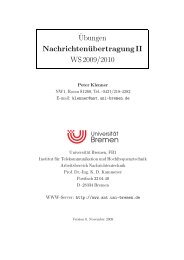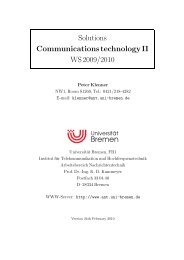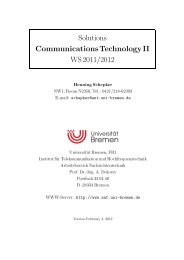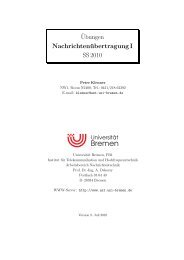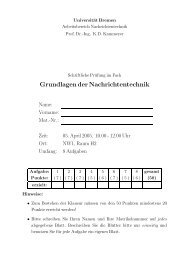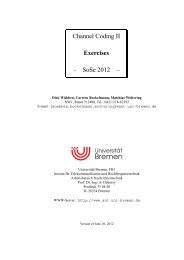Adaptive MIMO-OFDM for Future Mobile Radio Communications
Adaptive MIMO-OFDM for Future Mobile Radio Communications
Adaptive MIMO-OFDM for Future Mobile Radio Communications
Create successful ePaper yourself
Turn your PDF publications into a flip-book with our unique Google optimized e-Paper software.
<strong>Adaptive</strong> <strong>MIMO</strong>-<strong>OFDM</strong> <strong>for</strong> <strong>Future</strong> <strong>Mobile</strong> <strong>Radio</strong><strong>Communications</strong>V. Kühn, R. Böhnke, K.-D. KammeyerUniversity of Bremen, Dept. of <strong>Communications</strong> EngineeringP.O. Box 330440, D-28334 Bremen, Germany{kuehn,boehnke,kammeyer}@ant.uni-bremen.de, Fax: +49 421 218 3341Keywords: <strong>Adaptive</strong> <strong>OFDM</strong>, <strong>MIMO</strong>, Channel Coding, Bitand Power LoadingAbstractThis paper addresses the topic of bit and power loading incoded <strong>MIMO</strong>-<strong>OFDM</strong> systems. Due to the need of designingcommunication systems with high spectral efficiencies, thecombination of multiple antennas at transmitter and receiverwith <strong>OFDM</strong> represents a promising approach. Moreover,channel knowledge at the transmitter can be exploited toadapt the transmission to the channel. While loading strategies<strong>for</strong> the uncoded case as well as the in<strong>for</strong>mation theoreticalsolution are already known, the optimum scheme is stillunknown <strong>for</strong> coded systems. In this paper, we compare differentloading approaches <strong>for</strong> coded systems with respect totheir error rate per<strong>for</strong>mance.1 IntroductionSince bandwidth is a limited and valuable resource, moderncommunication systems have to be designed to achieve veryhigh spectral efficiencies. One candidate <strong>for</strong> an appropriateair interface of future mobile radio systems is the multi-carriertechnique <strong>OFDM</strong> (Orthogonal Frequency Division Multiplexing)[1]. It has already proven its practicability by findingits way into various standards <strong>for</strong> broadcast as well as pointto-pointcommunications [5,6,7]. One of the main benefits isthe simple equalization of frequency selective channels.Additionally, <strong>OFDM</strong> allows an easy adaptation to the channelconditions due to its granularity in the frequency domain ifchannel knowledge is available at the transmitter.A second approach leading to high spectral efficiencies is touse multiple antennas at the transmitter as well as thereceiver. The high potential of multiple-input multiple-output(<strong>MIMO</strong>) systems stems from the fact that parallel datastreams can be transmitted thereby multiplying the achievabledata rate [12]. For frequency selective channels, acombination of <strong>OFDM</strong> and multiple antennas is obvious.In this paper, we consider a coded <strong>MIMO</strong>-<strong>OFDM</strong> system andassume perfect channel knowledge at transmitter and receiver.This assumption allows the exploitation of the eigenmodes ofthe <strong>MIMO</strong> channel and the transmission of independent paralleldata streams. Transmit power and signal constellationcan be individually chosen <strong>for</strong> each stream with respect to anappropriate optimization criterion.The paper is organized as follows: Section 2 describes thesystem model and Section 3 the investigated loading strategies.Simulation results comparing the different concepts arediscussed in Section 4 and concluding remarks can be foundin Section 5.2 System ModelThe structure of the <strong>MIMO</strong>-<strong>OFDM</strong> transmitter is depicted inFigure 1. The in<strong>for</strong>mation bits are first encoded by an FECencoder that is further specified in Section 4. The encodedstream is demultiplexed into N = NCNTlayers, where NCdenotes the number of <strong>OFDM</strong> subcarriers and N T the numberof transmit antennas. Since we assume perfect channelknowledge at transmitter and receiver, each layer isindividually modulated (block ‘M’) according to anappropriate signal constellation. As <strong>OFDM</strong> ensures that eachcarrier is only affected by flat fading, the <strong>MIMO</strong> channelcorresponding to carrier ν can be represented by an NR × NTmatrix with the singular value decompositionH νHH ν = UνΣνVν. The unitary NT× N Tmatrices V ν are used<strong>for</strong> a linear pre-processing in order to exploit the eigenmodesof the <strong>MIMO</strong> channel, i.e. the transmitted vector becomesx = V s with containing the data symbols.νν νCs νMMMMN TN CN TV 1V NCFigure 1: <strong>MIMO</strong>-<strong>OFDM</strong> transmitterN CN C<strong>OFDM</strong>N T<strong>OFDM</strong>The N symbols are subsequently assigned to N T streams eachcomprising N C symbols <strong>for</strong>ming one <strong>OFDM</strong> symbol perantenna.At the receiver depicted in Figure 2, <strong>OFDM</strong> demodulation isper<strong>for</strong>med at each of the N R antennas. Next, the permutation isreversed so that N C streams each containing the signals of N Rantennas are <strong>for</strong>med. The receive vector on theν -th subcarrier is given byy = H x + n .(1)ν ν ν ν
10 0 E b / N 0 in dB10 -1no loadingwaterfilling10 0 E b / N 0 in dB10 -1no loadingbit & power loadingbit loadingP outBER10 -210 -210 -310 -3-2 0 2 4 6 8Figure 3: Outage probability with and without water-fillingIn [10], a hard decision is assumed be<strong>for</strong>e the decoder. Thistransfers each of the parallel AWGN channels into a binarysymmetric channel (BSC), whose error probability can beminimized using the methods described in the previoussection. However, the reliability in<strong>for</strong>mation about the codebits is lost due to the quantization, which leads to a severeper<strong>for</strong>mance degradation that may even overcompensate thegains due to the adaptive transmission.An approximation <strong>for</strong> the coded BER with soft-inputdecoding is derived in [11]. Interestingly, the resulting rateallocation <strong>for</strong>mula is identical to (9) with SNR gap inverselyproportional to the minimum Hamming distance of thechannel code. This leads to the assumption that algorithmsoriginally developed <strong>for</strong> the uncoded case are also reasonable<strong>for</strong> coded transmission. So, all in all, both in<strong>for</strong>mationtheoretic and uncoded results appear to be suited <strong>for</strong> realisticcodes. However, while rate adaptation is not required <strong>for</strong>ideal coding schemes, it is essential in the absence of channelcoding. It is not intuitively clear, which approach turns out tobe better.4 Numerical ResultsIn order to evaluate the different loading strategies, weconsider a <strong>MIMO</strong>-<strong>OFDM</strong> system with NC= 32 carriers andNT= NR= 4 antennas at transmitter and receiver. Thechannel impulse responses consist of LH= 6 uncorrelatedcomplex Gaussian distributed taps with equal variance andthe received SNR per bit is defined asEbNRP= .(10)N R0Figure 3 shows the outage probability of the channel. Hereand in the following figures, solid, dashed, and dash-dottedlines correspond to data rates of R = 4, 8, and 12 bit/s/Hz ,respectively. It can be observed that the gain due to waterfillingdiminishes with increasing rate.10 -40 5 10 15Figure 4: Per<strong>for</strong>mance of different loading schemes <strong>for</strong>uncoded transmissionIn Figure 4, results <strong>for</strong> the uncoded case are depicted. Notsurprisingly, non-adaptive transmission per<strong>for</strong>ms poorly,because no diversity is used and weak subchannels dominatethe average error rate. Enormous improvements are possiblewith the bit and power loading algorithm described in Section3.2, where the maximum constellation size was limited to 256QAM. Most of the gain can already be achieved bycombining the resulting bit allocation with an equal powerdistribution among active subchannels, so power loadingseems to be less important.The loading algorithms were then applied to codedtransmission. Each codeword spans LF= 10 consecutive<strong>MIMO</strong>-<strong>OFDM</strong> symbols (consisting of LFNCN T= 1280QAM symbols) during which the channel remains constant.Figure 5 depicts the BER <strong>for</strong> a half-rate non-recursiveconvolutional code with generator polynomials (7,5) 8in octalrepresentation. Looking at a spectral efficiency ofR = 4 bit/s/Hz, we observe that pure bit loading shows thebest per<strong>for</strong>mance and is slightly better than the combinationof bit and power loading. Obviously, a power distributionen<strong>for</strong>cing equal bit error probabilities on all subchannels doesnot represent the optimum approach <strong>for</strong> coded systems. Thegain of bit loading compared to the non-adaptive systemsamounts to 5 dB at a bit error rate of 10-4 . The different slopesof the curves indicate that this code can not utilize the fulldiversity of the channel without bit loading. On the otherhand, water-filling per<strong>for</strong>ms even worse than the nonadaptivesystem. The reason is that the code is highly puncturedbecause bits assigned to channels with P μ= 0 are nottransmitted. This is in contrast to the case of bit loading,where all code bits are transmitted. For growing spectralefficiency, the water filling approach becomes the best choiceat low signal to noise ratios while pure bit loading per<strong>for</strong>msbest <strong>for</strong> medium and high SNR. For R = 12 bit/s/Hz, nearlyall channels – even the worst ones – have to be used so thatpuncturing has only a minor influence. The bit loading
10 -1no loadingwaterfillingbit & power loadingbit loading10 -1no loadingwaterfillingbit & power loadingbit loadingBER10 0 E b / N 0 in dB10 -2BER10 0 E b / N 0 in dB10 -210 -310 -310 -40 5 10 15Figure 5: Per<strong>for</strong>mance of different loading schemes <strong>for</strong> a halfrateconvolutional codescheme gains about 3 dB. A comparison with Figure 4 revealsthat <strong>for</strong> this high data uncoded adaptive transmission isanother 2.5 dB better, because due to the code rate Rc= 1/2each QAM symbol contains on average 6 code bits while themaximum is set to 8 bits, which limits the degrees of freedom<strong>for</strong> the loading process.Figure 6 shows the corresponding results <strong>for</strong> the turbo codeconsisting of two identical constituent encoders withgenerator polynomials (1,17 /13) 8and punctured to rateRc= 1/2. For low and medium spectral efficiencies, bitloading still per<strong>for</strong>ms best closely followed by bit and powerloading. The gains amount to 3 dB <strong>for</strong> R = 4 bit/s/Hz and1.5 dB <strong>for</strong> R = 8 bit/s/Hz. For an efficiency of R = 12 bit/s/Hz,the relations change and water filling achieves the lowesterror rate. Astonishingly, the combination of bit and powerloading per<strong>for</strong>ms worst. The gains reduce to less than 1 dB.For this powerful turbo code and the high spectral efficiency,the in<strong>for</strong>mation theoretical approach can be confirmed. Incontrast to the convolutional code, the turbo code is able toexploit the full spatial and frequency diversity contained inthe system.5 ConclusionsIt has been shown that loading strategies exploiting channelknowledge at the transmitter can improve the error rate per<strong>for</strong>mancesignificantly. For weak codes, pure bit loadingseems to be an appropriate choice while the water fillingapproach per<strong>for</strong>ms best <strong>for</strong> strong codes and extremely highspectral efficiencies. However, it is still an open question howoptimum bit and power loading has to be per<strong>for</strong>med <strong>for</strong> aspecific code.10 -40 2 4 6 8 10 12Figure 6: Per<strong>for</strong>mance of different loading schemes <strong>for</strong> a halfrateturbo codeReferences[1] J.A.C. Bingham. “Multicarrier Modulation <strong>for</strong> DataTransmission: An idea whose time has come”, IEEE<strong>Communications</strong> Magazine, pp. 5-14, (1990).[2] G. Caire, G. Taricco, E. Biglieri. “Optimum PowerControl Over Fading Channels”, IEEE Transactions onIn<strong>for</strong>mation Theory, 45(5), pp. 1468-1489, (1999).[3] J. Campello. ”Practical Bit Loading <strong>for</strong> DMT”, Proc.International Conference on <strong>Communications</strong> (ICC), pp.801-805, June 1999.[4] T.M. Cover, J.A. Thomas. Elements of In<strong>for</strong>mationTheory, Wiley & Sons, London, (1991).[5] Digital Audio Broadcast, http://www.worlddab.org.[6] Digital Video Broadcast, http://www.dvb.org.[7] IEEE 802.11, http://grouper.ieee.org/groups/802/11/.[8] D. Hughes-Hartogs. “Ensemble Modem Structure <strong>for</strong>Imperfect Transmission Media”, U.S. Patents No.4,679,227 and 4,731,816 and 4,833,706, (1989).[9] B.S. Krongold, K. Ramchandran, D.L. Jones.”Computationally Efficient Optimal Power AllocationAlgorithm <strong>for</strong> Multicarrier Communication Systems”,Proc. International Conference on <strong>Communications</strong>(ICC), pp. 1018-1022, June 1998.[10] C. Mutti, D. Dahlhaus, T. Hunziker, and M. Foresti. “Bitand Power Loading Procedures <strong>for</strong> <strong>OFDM</strong> Systems withBit-Interleaved Coded Modulation”, InternationalConference on Telecommunications (ICT), pp.1422-1427, 2003.[11] K. Song, A. Ekbal, and J.M. Cioffi. “<strong>Adaptive</strong>Modulation and Coding (AMC) <strong>for</strong> Bit-interleavedCoded <strong>OFDM</strong> (BIC-<strong>OFDM</strong>),” Proc. InternationalConference on <strong>Communications</strong> (ICC), pp. 3197-3201,June 2004.[12] E. Telatar. “Capacity of Multi-antenna GaussianChannels”, ATT-Bell Labs Internal Technical Memo,(1995).



